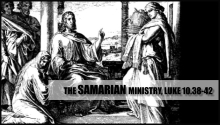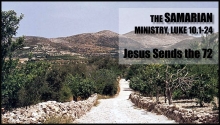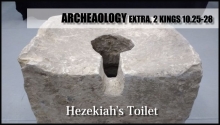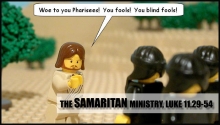
The day after the remarkable transfiguration event atop the mountain, Jesus, Peter, James and John came back down and were met by a large crowd. More importantly, they were immediately accosted by a distraught man whose son was oppressed by an unclean spirit. Apparently the nine disciples who did not accompany Jesus up the mountain the night before had tried to cast out the demon and failed. That in itself is a remarkable admission, especially since they had recently been going from town to town healing and casting out evil spirits (Luke 9.1-9). What was so special about this one?

This story is oddly out of place. We know Jesus has predicted his death – more than once – and that he is now on his way to Jerusalem for the final conflict. Along the way he travels through Samaria, and that in chapter nine, verse 51 Luke tells us Jesus is ministering in Samaria. We don’t have another shift until chapter 18 when we find Jesus leaving Samaria and heading toward Jericho (verse 35). So how is it that Jesus ends up at the home of Mary and Martha, which we know is about five miles east of Jerusalem in Bethany?

Jesus answered the question his disciples had put to him, “Teach us to pray” (see last week’s article, The Lord’s Prayer). Along with his lesson on how to pray, Jesus relates a story and other principles that are instructive regarding the topic. He begins, as Jesus is want to do, with an illustrative example that puts each member of the audience in the middle of the action. “Suppose one of you…” he began, received an unexpected visit from a distant friend who arrived in the middle of the night. Being unprepared, you immediately visit a neighbor to ask for some bread.

When in college an instructor of mine informed me of a lie she was about to tell her superiors. She had let some important communications slip through the cracks for some time and she wanted to lay the blame at my feet. The lie was an attempt to keep her job. I warned her not to, that her best hope lay in telling the truth. “The truth always comes out,” I said. She proceeded with the lie. As I’d warned, the truth would not remain silent. She did not return to teach the next semester.

Luke transitions now from Jesus’ time among the people of the Galilee to his ministry among the Samaritans. This is a curious choice given the antagonism between Jews and Samaritans. After the death of King Solomon trouble spread across Israel, and the kingdom became divided. The Samaritans were a part of the Northern kingdom and comprised of the tribes of Manasseh and Ephraim. Under the wicked king Jeroboam, a new capital for worship was created on Mount Gerizim. He mixed Judaism with pagan ritual and as punishment for doing so God allowed the Northern kingdom to fall to the Assyrians…

When one thinks of spiritual growth we have been trained to think in terms of two disciples, Bible study and prayer. While these are important, we at Think-Biblically.com have been trying to overcome this most basic train of thought. It is not enough to know Scripture and pray daily if it is merely a spiritual exercise. More important than these is building connections with God. This in no way is meant to diminish prayer in one’s life, however, as prayer is one way in which we can build that connection. Something we intend to prove by studying Jesus’ teaching on the subject.

The New Testament is replete with information about the existence of demons. Interestingly, there is no intention on the part of the authors to teach about the demonic, leaving us to work out what we can through the various accounts. On this occasion Jesus was casting out “a demon that was mute.” While the Greek is unclear we learn in the next verse it was not actually the demon who was mute, but was a symptom of possession the demon caused in its victim: “When the demon had gone out, the man who had been mute began to speak” (emphasis mine).

Jesus continues his lesson on authority with a little help from the crowd. A man approached Jesus, perhaps with his brother in tow (we’re not told, but it would make sense given the context), and asks Jesus to command his brother to share their father’s inheritance with him. Some may take this as an acknowledgement of Jesus’s authority. Yet Jesus refuses to judge such matters not because he doesn’t have the authority to do so, but because he see’s such judgments as trivial distractions. Instead of issuing a verdict, he issues an edict through the form of a parable.

Since the sending out of the 12 worked so well in the last chapter, Jesus decides to send out the 72 (his “second string” of disciples, if you will) for the same mission. There is an important difference between the two, however. The 12 were sent to various Jewish villages around the Sea of Galilee but his mission is Samaritan villages. They were given the same instructions as the apostles and went ahead to several towns Jesus would visit himself. They were to proclaim that the Kingdom of God was near and prove their message through healing and casting out unclean spirits.

Archaeologists at Tel Lachish, the ruins of a city in the Kingdom of Judah until its destruction in 701 BC, discovered an ancient toilet. While normally such a discovery might make for some entertaining headlines, it wouldn’t be considered of much importance. It is the location of this particular commode that makes it newsworthy. It was found in a shrine-like room which also contained cult figures, badly damaged ones at that, their horns smashed. The Times of Israel reports that it appears ancient Israelites installed the john in this alter room as a way to desecrate the idols.

Luke tells us that the crowds grew larger, and Matthew tells us that some teachers of the law asked Jesus for a sign to prove his message was from God. While Jesus could have proven his message through a sign, for he had done so many, many times before, he chose to give them no sign (which sparks a conflict that will continue to balloon until things get really intense). Instead he mentions two Gentile people, the people of Nineveh and the Queen of Sheba, both of whom had believed God’s messengers (Jonah and Solomon respectively) without receiving a sign. These Gentiles believed and changed how they lived in light of God’s revelation alone.

Still speaking to his disciples, Jesus tells us some truths about his mission that appear contradictory to how most view Jesus and his work. At Christmas we sing “Peace on Earth, good will toward men” but Jesus isn’t so gentle. “Do you think I’ve come to bring peace on earth? No, I tell you, but division!” He talks about “fire” on the earth and vitriol in the home and how it is all purposeful. Difficult teachings to hear, particularly to those who hold that the Old Testament is the anger and vengeful part of the Bible and the New Testament is full of puppies and kittens.
